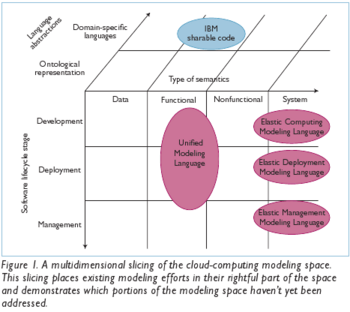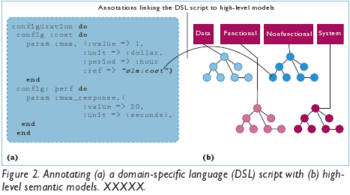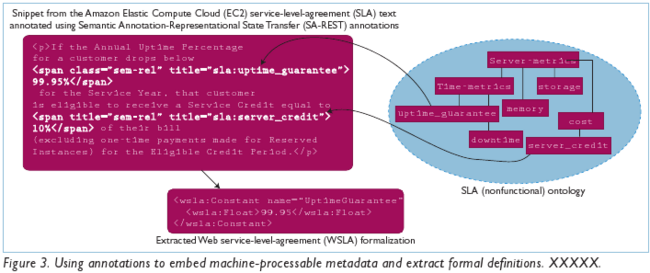Modeling for cloud part1
|
Semantic Modeling
Part 1 of this two-part article discussed
challenges related to cloud computing,
cloud interoperability, and multidimen-
sional analysis of cloud-modeling requirements
(see the May/June issue). Here, we look more
specifically at areas in which semantic models
can support cloud computing. tics, however, are similar. Metadata added
through annotations pointing to generic opera-
tional models would play a key role in consoli-
dating these APIs and enable interoperability
among the heterogeneous cloud environments. | ||
|
to the availability of extensible interpreted programming languages such as Ruby and Python. Unlike UML, a DSL is applicable only in a given domain but enables a light- weight model in that domain, often without requiring proprietary tools. For example, you can use IBM’s Sharable Code DSL (http://services. alphaworks.ibm.com/isc), which is a mashup generator, with a basic text editor. (However, providing graphical abstractions and specialized tooling would be more convenient for users.) “Lightweight” signifies that these models don’t use rich knowledge rep- resentation languages and so have limited reasoning capabilities. Our Cirrocumulus project for cloud interoperability (http://kno- esis.org/research/srl/projects/cir- rocumulus) uses DSLs to bridge the gap between executable artifacts and high-level semantic models. A DSL, although domain specific, can provide a more programmer-oriented representation of functional, non- functional, or even data descriptions. A best-of-both-worlds approach is to use annotations to link mod- els, which provides the convenience of lightweight models while sup- porting high-level operations when required. Figure 2 shows an annota- tion referring to an ontology from a fictitious DSL script for configu- ration. The script is more program- mer-oriented (in fact, it’s derived from Ruby) but lacks an ontology’s richness. However, the annota- tion links the relevant components between the different levels, pro- viding a way to facilitate high-level operations while maintaining a simpler representation. From the perspective based on the type of semantics and software lifecycle stage—that is, looking at the cube in Figure 1 from the front—you can see the modeling coverage for software deployment and manage- ment. Elastra’s Elastic Computing Modeling Language (ECML), Elas-
|
||
|
exploiting these data stores requires substantial redesign of many data- driven applications and often makes porting data to a traditional rela- tional database extremely difficult. The current practice is to address such transitions case-by-case. A better approach is to model the data in RDF and generate the specific target representations, and in some cases even the code for the applica- tion’s data access layer. This method can formulate transformations from one representation to another using the lifting-lowering mechanism. Semantic Annotations for WSDL and XML Schema (SAWSDL; www. w3.org/TR/sawsdl) demonstrated this mechanism’s use for data mediation. 2 Lightweight modeling in terms of DSLs also applies here. For example, the Web services community has long used XML Schema definitions as platform-agnostic data definitions. Schema definitions serve as inputs to code generation tools that generate platform-specific data definitions. From the perspective of the type of semantics and software lifecycle stage, most of this data modeling applies during application develop- ment. Concrete artifacts generated from these high-level models would be used mostly during subsequent lifecycle stages.
Service Enrichment One feature differentiating the cloud from other distributed environments is the availability of Web services to manipulate resources. Avail- ability of the service APIs lets you programmatically manage the cloud resources, even from within the same cloud. These capabilities have revolutionized application deploy- ment and management. For example, you can compose or mash up well- defined services to facilitate elabo- rate workflows. Service definitions are usually syntactic, and many researchers have focused on embedding rich metadata in formal service descrip- tions. One result of this research is SAWSDL. A growing trend is to annotate HTML descriptions to embed richer, machine-readable semantic metadata. One reason for this method’s popularity is search engines’ use of metadata to dis- play results in customized formats. Yahoo’s SearchMonkey and Google Rich Snippets are two such micro- format-driven schemes. These anno- tations, unlike the DSL annotations in Figure 3, might not always point to ontologies. Their structure can be based on a vocabulary or taxonomy— a lower-grade nonsemantic model. For example, the popular hCalendar microformat is part of the “lowercase semantic web” movement, which emphasizes lightweight models. Embedding rich semantic meta- data in cloud service descriptions has three main benefits that go beyond customized search capabilities. The first benefit deals with Rep- resentational State Transfer (REST) style services. Many cloud service providers adopt REST-style Web ser- vices that don’t advocate a formal service description. These services are described using HTML pages. WSDL 2.0, the latest specification, explicitly supports formal descrip- tion of “RESTful” services but hasn’t seen quick adoption. Alternative approaches such as SA-REST3 (SA stands for semantic annotation), a generic annotation scheme that fol- lows microformat design principles, are becoming more applicable in this space. These annotations enable the seamless, flexible integration of formalizations into RESTful service descriptions. This opens the door to many exciting avenues such as faceted search to identify relevant reusable services and semiautomated service compositions. The second benefit deals with handling change. The cloud space is still evolving. If the history of soft- ware or component interoperability |


